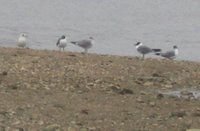Summer birding in DC can sometimes be kind of slow. While listserve reports indicate that some birds are already making their way south, autumn migrats have not yet reached the District in significant numbers. Just two months ago, the woods and fields rang with song from many colorful birds. Now, a hungry listener hears only an occasional song; even most local birds have quieted down. What we have left are the local breeders, which were in evidence at the National Arboretum this morning. The meadows around the columns held American goldfinches and indigo buntings, both of which were still singing. I imagine these species are holding down territories for second broods. Inside Fern Valley, I found a young brown-headed cowbird begging for food from a stressed-looking Carolina wren. I did not see the wren feed the cowbird, but this appeared to be a "family" group. Several acadian flycatchers called in the woods, while wood thrushes sang faintly.
What we have left are the local breeders, which were in evidence at the National Arboretum this morning. The meadows around the columns held American goldfinches and indigo buntings, both of which were still singing. I imagine these species are holding down territories for second broods. Inside Fern Valley, I found a young brown-headed cowbird begging for food from a stressed-looking Carolina wren. I did not see the wren feed the cowbird, but this appeared to be a "family" group. Several acadian flycatchers called in the woods, while wood thrushes sang faintly.
From the valley, I walked down to the start of the river trail, where there were northern parulas singing. The meadow at the south end of the trail had a singing blue grosbeak. It was a accompanied a female (possibly a hatch year bird). Blue grosbeaks and indigo buntings both are beautifully blue. Indigo buntings have a blue so intense and bright it appears they do not belong in the wild; blue grosbeaks have a wonderfully rich blue, darker than the bunting. Nearby three young eastern phoebes perched on the Arboretum's security fence. As I walked the river trail, I was a little worried that the gate on the other end would be locked. As it turned out, I need not have worried. The gate was locked, but unhinged due to some unknown agent.
I just missed the bus at the visitor center, so I took a quick turn through the Azalea Gardens. On the far side their was a brown thrasher skulking in the shrubs. Somewhere a yellow-billed cuckoo yowlped. I am not good at digging these birds out of the foliage, so I let it pass. The barn swallows that had nested at the visitor center appear to be finished there for the season. Later in the afternoon I checked out the birds at Anacostia Park. Here there were two clear autumn migrants: ring-billed gull and laughing gull. (Maybe autumn migration is not quite right; post-breeding dispersal might be more accurate.) Both were using the mud flats left by the river at low tide. There were about 10-15 laughing gulls and about twice as many ring-billed gulls. The gulls are mostly adults at this point. Several killdeer were also using the southernmost mudflat, near Poplar Point. No terns have appeared yet, but they should be along shortly. One surprise gadwall was in the river. That is an unusual bird for DC. There were few songbirds of interest here, aside from a yellow orchard oriole that flew across the road in front of me.
Later in the afternoon I checked out the birds at Anacostia Park. Here there were two clear autumn migrants: ring-billed gull and laughing gull. (Maybe autumn migration is not quite right; post-breeding dispersal might be more accurate.) Both were using the mud flats left by the river at low tide. There were about 10-15 laughing gulls and about twice as many ring-billed gulls. The gulls are mostly adults at this point. Several killdeer were also using the southernmost mudflat, near Poplar Point. No terns have appeared yet, but they should be along shortly. One surprise gadwall was in the river. That is an unusual bird for DC. There were few songbirds of interest here, aside from a yellow orchard oriole that flew across the road in front of me.
BIRD SPECIES: 54 Double-crested Cormorant
Double-crested Cormorant
Great Blue Heron
Canada Goose
Gadwall
Mallard
Osprey
Red-shouldered Hawk
Killdeer
Ring-billed Gull
Laughing Gull
Rock Pigeon
Mourning Dove
Yellow-billed Cuckoo
Chimney Swift
Belted Kingfisher
Red-bellied Woodpecker
Downy Woodpecker
Hairy Woodpecker
Northern Flicker
Eastern Wood-Pewee
Acadian Flycatcher
Eastern Phoebe
Eastern Kingbird
Barn Swallow
Carolina Wren
House Wren
Gray Catbird
Northern Mockingbird
Brown Thrasher
Eastern Bluebird
Wood Thrush
American Robin
Blue-gray Gnatcatcher
Carolina Chickadee
Blue Jay
American Crow
Fish Crow
European Starling
House Sparrow
Red-eyed Vireo
House Finch
American Goldfinch
Northern Parula
Common Yellowthroat
Eastern Towhee
Chipping Sparrow
Song Sparrow
Northern Cardinal
Blue Grosbeak
Indigo Bunting
Red-winged Blackbird
Common Grackle
Brown-headed Cowbird
Orchard Oriole
BUTTERFLY SPECIES: 5
Eastern Tiger Swallowtail
Cabbage White
Clouded Sulphur
Common Wood-Nymph
Horace's Duskywing
ODONATE SPECIES: 3
Ebony Jewelwing
Common Whitetail
Eastern Amberwing



